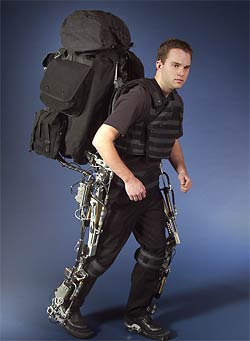http://www.berkeley.edu/news/media/releases/2004/03/03_exo.shtml
http://me.berkeley.edu/hel/bleex.htm
http://me.berkeley.edu/hel/bleex.htm

BERKELEY The mere thought of hauling a 70-pound pack across miles of rugged terrain or up 50 flights of stairs is enough to evoke a grimace in even the burliest individuals. But breakthrough robotics research at the University of California, Berkeley, could soon bring welcome relief a self-powered exoskeleton to effectively take the load off peoples backs.
"We set out to create an exoskeleton that combines a human control system with robotic muscle," said Homayoon Kazerooni, professor of mechanical engineering and director of UC Berkeleys Robotics and Human Engineering Laboratory. "Weve designed this system to be ergonomic, highly maneuverable and technically robust so the wearer can walk, squat, bend and swing from side to side without noticeable reductions in agility. The human pilot can also step over and under obstructions while carrying equipment and supplies."
The Berkeley Lower Extremity Exoskeleton (BLEEX), as its officially called, consists of mechanical metal leg braces that are connected rigidly to the user at the feet, and, in order to prevent abrasion, more compliantly elsewhere. The device includes a power unit and a backpack-like frame used to carry a large load.
Such a machine could become an invaluable tool for anyone who needs to travel long distances by foot with a heavy load. The exoskeleton could eventually be used by army medics to carry injured soldiers off a battlefield, firefighters to haul their gear up dozens of flights of stairs to put out a high-rise blaze, or rescue workers to bring in food and first-aid supplies to areas where vehicles cannot enter.
"The fundamental technology developed here can also be developed to help people with limited muscle ability to walk optimally," said Kazerooni.
The researchers point out that the human pilot does not need a joystick, button or special keyboard to "drive" the device. Rather, the machine is designed so that the pilot becomes an integral part of the exoskeleton, thus requiring no special training to use it. In the UC Berkeley experiments, the human pilot moved about a room wearing the 100-pound exoskeleton and a 70-pound backpack while feeling as if he were lugging a mere 5 pounds.
The project, funded by the Defense Advanced Research Projects Agency, or DARPA, began in earnest in 2000. Next week, from March 9 through 11, Kazerooni and his research team will showcase their project at the DARPA Technical Symposium in Anaheim, Calif.
For the current model, the user steps into a pair of modified Army boots that are then attached to the exoskeleton. A pair of metal legs frames the outside of a persons legs to facilitate ease of movement. The wearer then dons the exoskeletons vest that is attached to the backpack frame and engine. If the machine runs out of fuel, the exoskeleton legs can be easily removed so that the device converts to a large backpack.
More than 40 sensors and hydraulic actuators form a local area network (LAN) for the exoskeleton and function much like a human nervous system. The sensors, including some that are embedded within the shoe pads, are constantly providing the central computer brain information so that it can adjust the load based upon what the human is doing. When it is turned on, the exoskeleton is constantly calculating what it needs to do to distribute the weight so little to no load is imposed on the wearer.
"We are taking great pains to make this as practical and robust as possible for the wearer," said Kazerooni. "Several engineers around the world are working on motorized exoskeletons that can enhance human strength, but weve advanced our design to the point where a pilot could strap on the external metal frame and walk in figure eights around a room. No one else has done that."
One significant challenge for the researchers was to design a fuel-based power source and actuation system that would provide the energy needed for a long mission. The UC Berkeley researchers are using an engine that delivers hydraulic power for locomotion and electrical power for the computer. The engine provides the requisite energy needed to power the exoskeleton while affording the ease of refueling in the field.
The current prototype allows a person to travel over flat terrain and slopes, but work on the exoskeleton is ongoing, with the focus turning to miniaturization of its components. The UC Berkeley engineers are also developing a quieter, more powerful engine, and a faster, more intelligent controller, that will enable the exoskeleton to carry loads up to 120 pounds within the next six months. In addition, the researchers are studying what it takes to enable pilots to run and jump with the exoskeleton legs.
The engineers point out that while the exoskeleton does the heavy lifting, the human contributes to the balance. "The pilot is not driving the exoskeleton," said Kazerooni. "Instead, the control algorithms in the computer are constantly calculating how to move the exoskeleton so that it moves in concert with the human."
Appropriately enough, the first step in the project began with researchers analyzing the human step. They gathered information about how people walk and move including the propulsive force and torque needed from the ankles and the shock absorbing power of the knees so they could adapt the exoskeleton to a wide range of natural human movements.
"Many scientists and engineers have been attempting to build a robotic strength enhancing device since the 1950s, and theyve failed," said Kazerooni. "It is only through recent engineering breakthroughs that this dream is now becoming a reality."




